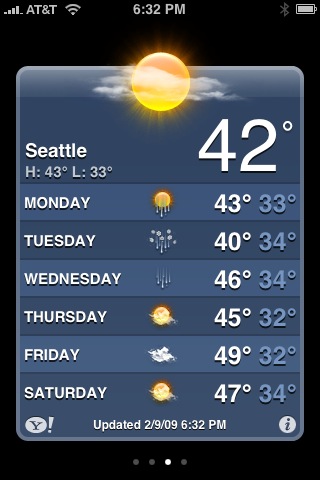Chapter 2 was a little on Physical Environment, "Where you live affects how much and what part of the physical environment you notice, but the amount of attention is governed by how the physical environment is modified". In Seattle you can definitely see it's physical environment. The ocean at the side of it and nice mountains around it. Seattle's environment is one of it's own. I really don't think that there is another state like Seattle. Seattle is located between Puget Sound to the west and Lake Washington to the east. The city's chief harbor, Elliot Bay, is an inlet of Puget Sound. To the west, beyond Puget Sound, are the Kitsap Peninsula and Olympic Mountains on the Olympic Peninsula; to the east, beyond Lake Washington and the eastside suburbs, are Lake Sammamish and the Cascade Range. Lake Washington's water flow to Puget Sound through the Lake Washington Ship canal, Lake Union, and the HIram C. Chittended Locks at Salmon Bay, ending in Shilshole Bay.

The city is essentially hilly. The city lie on seven hills including the Capitol Hill, Queen Anne, First Hill, West Seattle, Beacon Hill and Denny Hill. The hilliest areas are concentrated near the city center. Capitol Hill, First Hill and Beacon Hill collectively forms a ridge between the Elliot Bay and Lake Washington. The layout orientation of Seattle downtown has been reshaped by various man made constructions like the Lake Washington Ship canal an artificial waterway linking Puget Sound and Lake Washington, Harbor Island an artificial island constructed in the mouth of Duwamish Waterway. Downtown Seattle is a busy commercial center with high rise buildings and residential areas overlooking a panoramic waterfront.

Mountains were discussed in the book, and Seattle has many of them. Mountains are a great part of the physical landscape and it is in many places among the U.S. Seattle, Washington is home to a total of 12 mountain summits and peaks: Beckstrom Hill Summit, Blakely Rock Pillar, Cougar Mountain Summit, Denny HIlls Summit, Duwasmish Head Cliff, First Hill Summit, MAgnolia Bluff Cliff, Newcastle Hills Range, Norway Hill Summit, Orchard Rocks Summit, Pigeon Point Cliff and Queen Anne Hill Summit.


Climate was another topic in Chapter 2 and it explains how climate affects the states, and how its depending on its latitude the weather behaves respectively. "Proximity to large water bodies also tends to produce more precipitation, with coastal precipitation, with coastal locations receiving generally higher amounts." this is a perfect example of Seattle. Downtown Seattle averages 71 clear (sunny) days a year, with most of those days occuring between May and September. Seattle weather is mild and can be classified as typical Marine West Coast climate. It also exhinits some characteristics of a Mediterranean climate with wet winters and dry summers. The topographical features play vital roles in controlling Seattle climate. Seattle's mild winters and cool summers work together to make the city lush and green, earning it the nickname "The Emerald City". Water bodies like the Pacific Ocean and the Puget Sound have a moderating effect on the extreme temperatures. The harsh effects of the Pacific Storm are nulled by the huge Olympic mountains, which obstruct its way whereas, the chilly Arctic air is stopped by the Cascade Range. In spite of lying on the rain shadow area of the Olympic Mountains the city receives rainfall throughout the year. Seattle receives frequent rains in the form of drizzle or light rains with occasional downpours. The normal average yearly rainfall in Seattle is approximately 37 inches. Most of the time cloudy skies prevail over Seattle. Heavy rainfall occurs between January and May and between October and June. Best time to visit Seattle are the dry months of June, July and August. Seattle summers are usually cool and mild. Specific years are characterized by a week long heat spells. Weatehr in Seattle during the summers is usually dry with occasional thunderstorms. Seattle winters are also mild with less days of snowfall. A number of damaging winter storms and, wind storms and low land snow have occurred during years 2006 and 2007. However, the Puget Sound Convergence weather syndrome, causes unpredictable fluctuations with rains and thunderstorms even during the dry months. this unique meteorological phenomena is caused when the Olympic mountains deflect the winds blowing from the Pacific. These winds converge again over the Pugent Sound causing convectional rainfall, in the form of drizzle or a thunderstorm. Wind components determine the intensity of the turbulence.



Text Sources: http://en.wikipedia.org/wiki/Seattle, http://beautifulseattle.com/, http://www.mapsofworld.com/, http://www.mountainzone.com/, Textbook.
Picture Sources: www.operatorchan.org/wallz/6.html, www.seattlecontactimprovisation.com/lakes-list-in-united-states/index.html, www.fotopedia.com/albumsB16jsBQHNR&./entries/29n7fd9r8Gw, www.flickriver.com/photosjcolman/34758381051, www.depts.washington.edu/ictll39/weather.html, www.sfgate.com/.../green/detal?entry-id=33911, www.bloodhoundrealty.com/BloodhoundBlog/?p=6856.
No comments:
Post a Comment